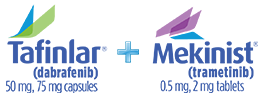
BRAF Testing
BRAF Mutation Testing
Test early for BRAF V600E mutations and other actionable alterations
Testing modalities used to identify BRAF V600E mutations:
Next-generation sequencing (NGS): scalable DNA sequencing that is able to simultaneously analyze multiple genes1,2 | |
Mutation-specific polymerase chain reaction (PCR): rapidly making copies of small segments of DNA3 | |
Mutation-specific real-time PCR (rtPCR): a more sensitive technique than traditional PCR where targeted DNA segments are amplified and quantified simultaneously1-3 | |
Immunohistochemistry (IHC): detects tumor cells harboring a specific antigen by cytoplasmic staining of cells containing a mutation-specific monoclonal antibody4 | |
Other testing methods: Sanger sequencing, pyrosequencing1,2 |
In the ROAR Study, BRAF mutation status was determined using a range of methods, including NGS, IHC, PCR, dideoxy DNA sequencing, pyrosequencing, and mass spectrometry.2
Confirm the presence of BRAF V600E mutation in tumor specimens prior to initiation of treatment with TAFINLAR and MEKINIST. An FDA-approved test for the detection of BRAF V600E mutation in solid tumors other than melanoma and non-small cell lung cancer is not currently available.5,6
